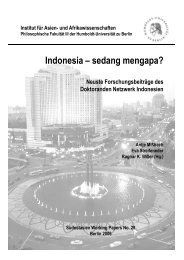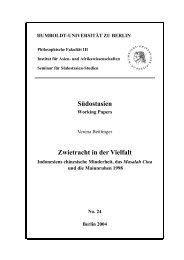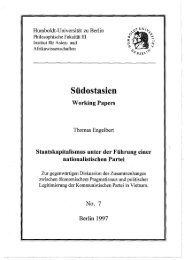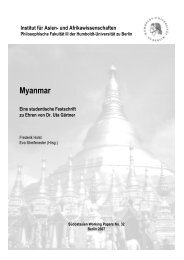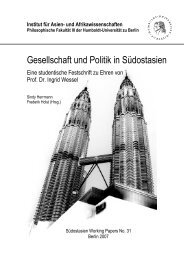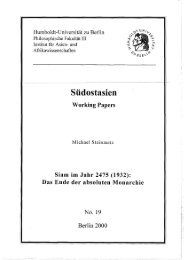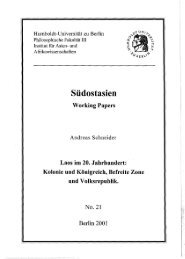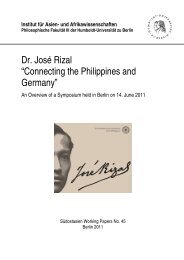On Centrism and Dualism - Humboldt-Universität zu Berlin
On Centrism and Dualism - Humboldt-Universität zu Berlin
On Centrism and Dualism - Humboldt-Universität zu Berlin
Create successful ePaper yourself
Turn your PDF publications into a flip-book with our unique Google optimized e-Paper software.
INTRODUCTION<br />
HEADLEY’S argument introduces siblingship as the essential concept for imagining <strong>and</strong><br />
expressing unity in Southeast Asia.<br />
I will show that it is the valuation of unity that also represent the fundamental idea of<br />
ERRINGTON’S comparative model. In her model the universal valuation of siblingship, its role<br />
in imagining unity, <strong>and</strong> its relevance for establishing houses as ritual centers, constitutes the<br />
common theme of viewing Southeast Asian social formation as Houses. In this context I will<br />
highlight the importance of siblinghship as a heuristic category for the analysis of isl<strong>and</strong><br />
Southeast Asian social formations.<br />
For a long time siblingship has been neglected in the anthropology of Southeast Asia. Jeremy<br />
KEMP <strong>and</strong> Frans HÜSKEN (1991) claim that anthropologists working on Southeast Asia have<br />
contributed two important themes to the general anthropological discourse, both are to be<br />
found in the realm of kinship studies. Firstly, they refer to the analysis of what is known as<br />
asymmetric marriage alliance 9 . Secondly, they highlight the rather blurred category of<br />
cognatic societies, or cognatic kinship systems.<br />
Of the two, the former achieved early prominence due to anthropology’s general emphasis on<br />
unilineal descent<br />
10 (ibid.: 1). 11 Therefore, cognatic systems were analytically neglected, if not<br />
totally ignored. Even today cognatic systems do not receive the attention that one might<br />
legitimately assume to be their due, given their demographic preponderance (the majority of<br />
Southeast Asia’s population is living in cognatic societies) (ibid.). These two analytic<br />
concepts, which emphasize affinity <strong>and</strong> cognation respectively, are intended to describe the<br />
9 Asymmetric alliance describes systems in which women move asymmetrically between hierarchically<br />
differentiated alliance groups, so that Ego’s group takes women from a different group than the one it gives them<br />
to, which implies a minimum of three exchange groups. These exchange groups are generally understood as<br />
unilineal descent groups, a principle of descent that stresses either the male or female side (cf. NEEDHAM 1979:<br />
36-37).<br />
10 In traditional kinship theory the relation between parent <strong>and</strong> child is understood as ties of filiation, sometimes<br />
specified further as patrifiliation or matrifiliation. Filiation links are repeated generation after generation, <strong>and</strong> if<br />
the social emphasis is on the whole series of such links then one talks of descent. Very often, links traced<br />
through one parent are emphasized at the expense, relatively or absolutely, of those through the other. If links<br />
through the father are emphasized, there is patrilineal or agnatic descent; if the mother represents the focus of<br />
linkage, then there is matrilateral or uterine descent. In both cases, descent is unilineal, the descent line formed<br />
by these links being traced back in time through persons of the same sex to the ancestor or founder of the line<br />
(PARKIN 1997: 15). Groups that recruit their members according to unilineal principles are therefore called,<br />
unilineal descent groups. For a detailed account of the anthropological concept of descent group, see DUMONT<br />
(2006 [1971]). The study of social structure represents the main focus of British social anthropology during the<br />
1940s <strong>and</strong> 50s. British social anthropologists, mainly working on Africa, were concerned with the analysis of the<br />
political organization in societies lacking centralized political institutions. The theory of unilineal descent groups<br />
dominated these investigations, as exemplified in Meyer FORTES (1953) article The Structure of Unilineal<br />
Descent Groups. This anthropological perspective is also known as descent theory. For an apt summary of how<br />
the relationship between British anthropologists <strong>and</strong> descent theory evolved see BERGER (2000: 38-43).<br />
11 An example of this prominence in the context of isl<strong>and</strong> Southeast Asia is J.P.B. DE JOSSELIN DE JONG’S (1977<br />
[1935]) so called ‘Field of Ethnological Study’ (FES), that deals exclusively with unilineal societies practicing<br />
asymmetric marriage alliance.<br />
8



